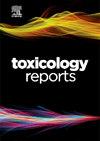二苯甲酮对大鼠组织病理学的毒性作用评价。
Q1 Environmental Science
引用次数: 0
摘要
二苯甲酮(BP)是一种有机紫外线(UV)过滤器,广泛用于防晒霜和个人护理产品中。该化合物通过工业化、污水处理厂和生活污水进入水生生态系统,对水生生物构成严重威胁,被认为是一种新兴污染物。本研究以实验室为基础,评估了BP在96小时(h)的中位致死浓度(LC50)和亚致死效应对罗氏Labeo rohita鳃和肌肉的组织学影响。鱼小鱼相同的重量(48 ±2 g)和长度(5 ± 2 。)暴露在逐渐增加浓度的BP(100 1000µg / L µg / L)和96 - h LC50决心612.822 ±37.38 µg / L。为了确定亚致死效应,将鱼暴露于BP 96小时LC50的1/5中35天(d),以研究器官特异性反应。结果显示暴露器官明显受损,柱状细胞受损,鳃黏液细胞腔内碎片受损。此外,在暴露的肌肉中观察到完整肌肉结构的断裂,腔内碎片和血管坏死。综上所述,这些结果证实了BP暴露导致罗氏乳杆菌鳃部和肌肉的组织病理学改变,从而证实了其对水生生物的风险。本文章由计算机程序翻译,如有差异,请以英文原文为准。
Evaluation of toxic effects of benzophenone on histopathology of Labeo rohita
Benzophenone (BP) is an organic ultraviolet (UV) filter widely used in sunscreens and personal care products. This compound enters aquatic ecosystems due to industrialization, wastewater treatment plants (WWTPs), and domestic effluents, poses serious threats to aquatic organisms, and is considered an emerging pollutant. This laboratory-based study assessed the 96-hour (h) median lethal concentrations (LC50) and sub-lethal effects of BP on the histology of the gills and muscles of Labeo rohita. Fish fingerlings of the same weight (48 ± 2 g) and length (5 ± 2 in.) were exposed to gradually increasing concentrations of BP (100 µg/L to 1000 µg/L) and their 96-h LC50 was determined as 612.822 ± 37.38 µg/L. To determine the sub-lethal effects, the fish were exposed to 1/5th of the 96-h LC50 of BP for 35 days (d) to investigate organ-specific responses. The results indicated significant damage to the exposed organs and showed damage in pillar cells and intraluminal debris in gill mucous cells. Moreover, fragmentation of intact muscle structures, intraluminal debris, and vascular necrosis were observed in exposed muscles. In conclusion, these results confirmed the histopathological changes in the gills and muscles of L. rohita caused by BP exposure, thereby confirming its risk to aquatic life.
求助全文
通过发布文献求助,成功后即可免费获取论文全文。
去求助
来源期刊

Toxicology Reports
Environmental Science-Health, Toxicology and Mutagenesis
CiteScore
7.60
自引率
0.00%
发文量
228
审稿时长
11 weeks
 求助内容:
求助内容: 应助结果提醒方式:
应助结果提醒方式:


